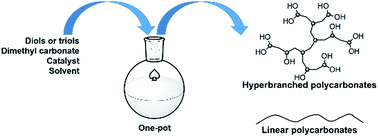A novel one-pot process for the preparation of linear and hyperbranched polycarbonates of various diols and triols using dimethyl carbonate†
Abstract
A new eco-friendly strategy for the preparation of linear and hyperbranched polycarbonates was developed. Our work referred to a one-pot condensation polymerization of various alcohols (diols and triols) with equivalent amounts of eco-friendly dimethyl carbonate (DMC) at 120 °C, atmospheric pressure and in 1,4-dioxane solution using 4-dimethylaminopyridine (DMAP) or lithium acetylacetonate (LiAcac) as a catalyst. Polymer chains were built by pure transesterification of hydroxyl and methyl carbonate chain ends, and the single byproduct (methanol) was removed using a pressure-equalized addition funnel filled with 4 Å molecular sieves as the crucial equipment in this work. Using this strategy, hyperbranched polycarbonates with high molar masses (Mn up to 10 000 g mol−1 and Mw up to 64 000 g mol−1) and high hydroxyl end group contents (up to 94%) were successfully prepared using dimethyl carbonate instead of toxic phosgene or phosgene-based monomers for the first time. In addition, linear aliphatic polycarbonates of various diols were also synthesized with Mn up to 16 000 g mol−1 and low molar mass distributions (ĐM < 1.70). Another eco-friendly aspect of this work was the use of equimolar amounts of DMC to avoid waste and the disposal of excess DMC; in a classic 2-step polycondensation for polycarbonate synthesis excess DMC is a prerequisite in order to obtain high molar masses.



 Please wait while we load your content...
Please wait while we load your content...